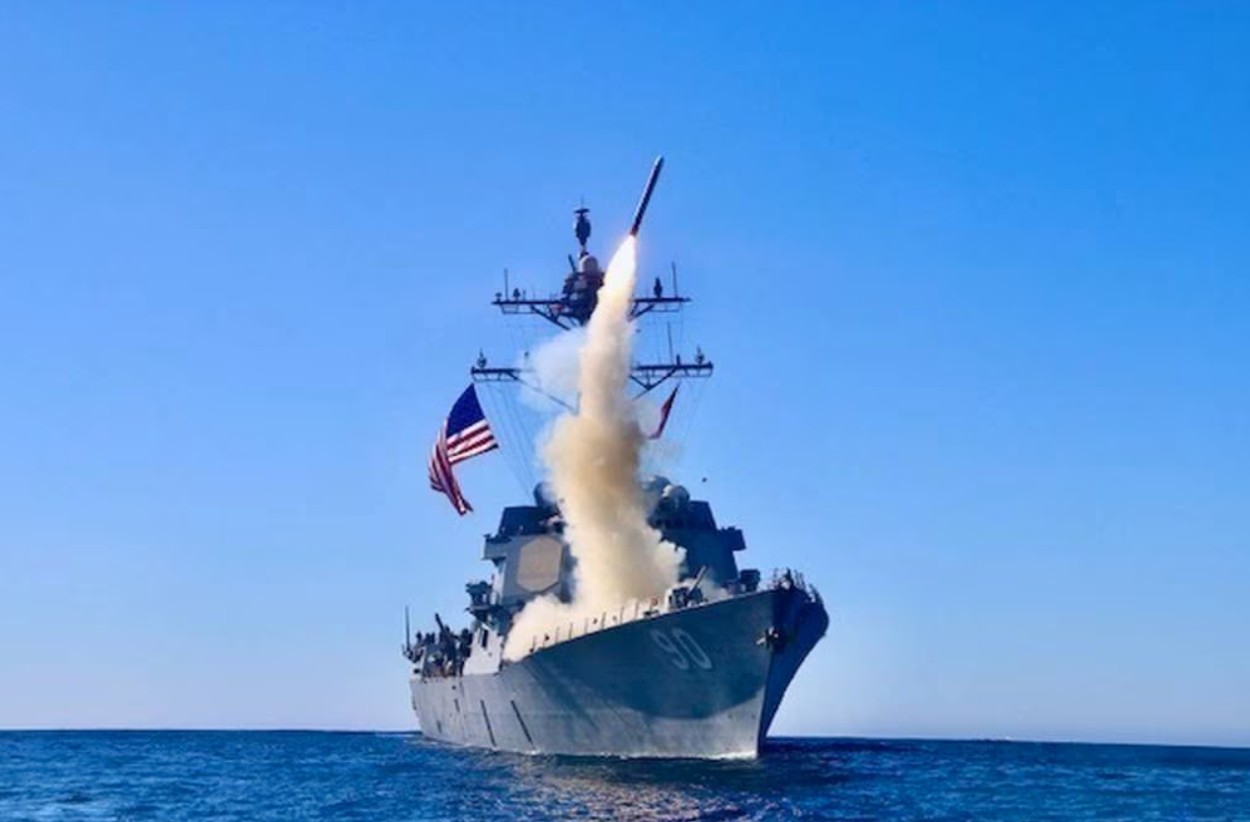In a key development aimed at bolstering Japan’s defense capabilities, the US Navy has commenced training sessions for Japan’s Self-Defense Forces (JSDF) on handling Tomahawk cruise missiles.
This initiative comes on the heels of Japan’s decision to procure up to 400 Tomahawks from the United States earlier this year, signifying a strategic move to enhance its counterstrike capabilities against potential threats.
The five-day inaugural training session kicked off on March 25, marking a pivotal moment in Japan’s defense modernization efforts. The training, conducted aboard a US Aegis destroyer anchored at the Yokosuka navy base just south of Tokyo, involved approximately 20 SDF personnel.
On March 28, some Japanese and US media were granted access to cover the training, which included hands-on experience in launching Tomahawk missiles using authentic equipment.
A spokesperson from the US Navy elaborated that the training on March 28 focused on imparting fundamental procedures for Tomahawk deployment.
While the initial training was slated to conclude on March 29, plans are underway for an advanced Tomahawk training program tailored for the SDF.
US Ambassador to Japan Rahm Emanuel visited the training site to observe the proceedings firsthand. Emanuel noted the significance of the training, describing it as scenario-based and integral to enhancing Japan’s maritime defense capabilities.
What does credible deterrence look like? Building Japan’s crucial counterstrike capability with week one of Tomahawk cruise missile training at @USNavy Yokosuka. Welcome to a new era in strength, security and stability in the Indo-Pacific region. pic.twitter.com/Puy28jM9HX
— ラーム・エマニュエル駐日米国大使 (@USAmbJapan) March 28, 2024
He underscored the importance of equipping Japan’s Maritime Self-Defense Force with the necessary tools and expertise, affirming the enduring partnership between the United States and Japan in fostering regional security and stability.
The ambassador also shared images of the training session. In a tweet accompanying the pictures, he stated, “What does credible deterrence look like? Building Japan’s crucial counterstrike capability with week one of Tomahawk cruise missile training at USNavy Yokosuka. Welcome to a new era in strength, security, and stability in the Indo-Pacific region.”
According to the 2023 budget from Japan’s Ministry of Defense, the Tomahawk land-attack cruise missiles (LACM) will be incorporated into the arsenal of the Japanese Maritime Self-Defense Force. The plan outlines the future deployment of these missiles on vessels equipped with Aegis ballistic missile defense systems.
Currently, Japan’s Atago and Maya-class cruisers and Kongou-class destroyers feature suitable-length Mk 41 vertical launch systems capable of launching the Tomahawk LACMs.
Further, the Japanese Maritime Self-Defense Force plans to outfit its Aegis-equipped vessels, including two new multi-role warships in development, with these missiles in the future.
This acquisition aligns with Tokyo’s broader strategy to enhance its ‘counter-strike’ capabilities, which encompasses acquiring a range of stand-off missiles domestically and internationally. With longer-range missiles at its disposal, Japan aims to potentially target areas across North Korea and parts of eastern and northeastern China from its territorial waters.
The Tomahawk Cruise Missile
Developed in the 1970s to tackle the challenges of modern warfare, the Tomahawk cruise missile has evolved from a niche solution to a pivotal component of military strategy, both in the United States and among its allies. With its long-range and precision strike capabilities, the Tomahawk has left an indelible mark on the landscape of modern conflict.
The Tomahawk has undergone continuous refinement over the years. It was originally conceived by General Dynamics to fulfill the US military’s need for a low-altitude missile operable from naval surface warfare platforms.
From its inception, more than a dozen variants have been introduced, each boasting enhancements of range, accuracy, and versatility.
Initially, General Dynamics was the sole supplier of the Tomahawk until McDonnell Douglass assumed control in the early 1990s, overseeing the production of Block II and Block III variants.
In the mid-1990s, Hughes Aircraft acquired General Dynamics’ missile division and advocated for a return to Tomahawk production. Since 1995, Raytheon Technologies has stood as the exclusive manufacturer of this formidable weapon system.
The Tomahawk’s operational prowess lies in its ability to strike targets with precision from extended distances — up to 900 nautical miles — while possessing the capability to loiter over objectives akin to unmanned aerial vehicles (UAVs). This dual functionality has positioned the Tomahawk as the military’s preferred first-strike weapon, particularly in the initial stages of conflict.

Since its baptism by fire during the 1991 Gulf War, where it made its combat debut, the Tomahawk has been a fixture in numerous military engagements worldwide.
During the Persian Gulf War, the USS Paul F. Foster launched the first Tomahawk missile, followed by nearly 300 additional launches from various US Navy vessels and submarines.
The televised images of Tomahawks streaking through the skies of Baghdad, as reported by Bernard Shaw on CNN, offered a glimpse of the weapon’s devastating effectiveness.
Subsequent deployments in conflicts such as Operation Allied Force in 1999 and the 2003 invasion of Iraq further solidified the Tomahawk’s reputation as a formidable precision strike weapon.
Its use, however, has not been without controversy. In a tragic incident on December 17, 2009, missiles targeting an alleged Al-Qaeda training camp in Yemen resulted in the deaths of 41 civilians, predominantly women and children.
Despite initial denials of responsibility by US and Yemeni officials, subsequent investigations, including those conducted by Amnesty International and revelations from WikiLeaks, implicated American Tomahawks launched from a naval vessel in the tragedy.
Despite such incidents, the Tomahawk remains a cornerstone of modern military strategy, offering unparalleled precision and lethality in conflicts worldwide.
Its evolution from a Cold War-era solution to a staple of modern warfare underscores its enduring significance in the arsenal of nations seeking to maintain their strategic edge in an ever-changing geopolitical landscape.
- Contact the author at ashishmichel(at)gmail.com
- Follow EurAsian Times on Google News




